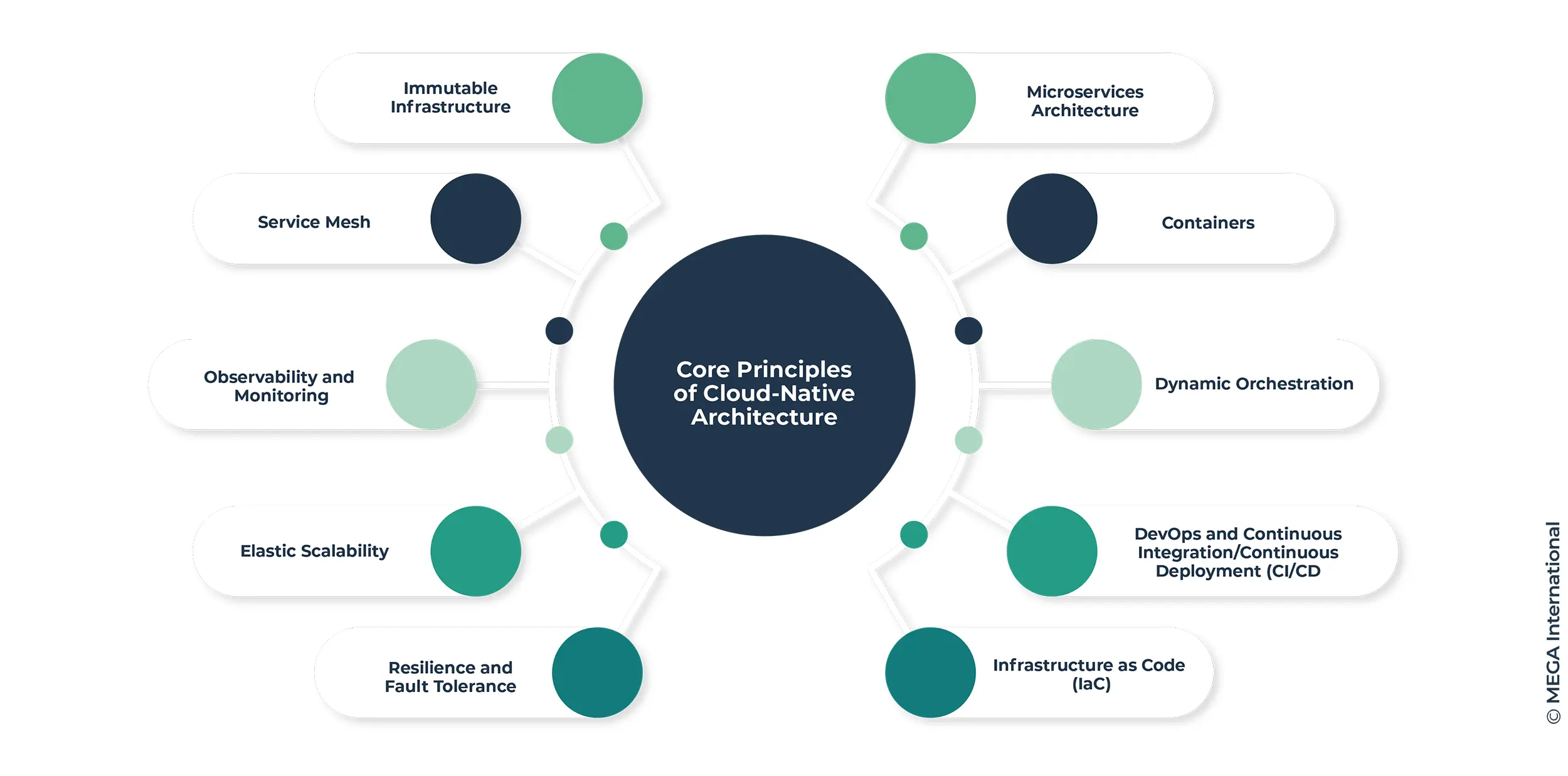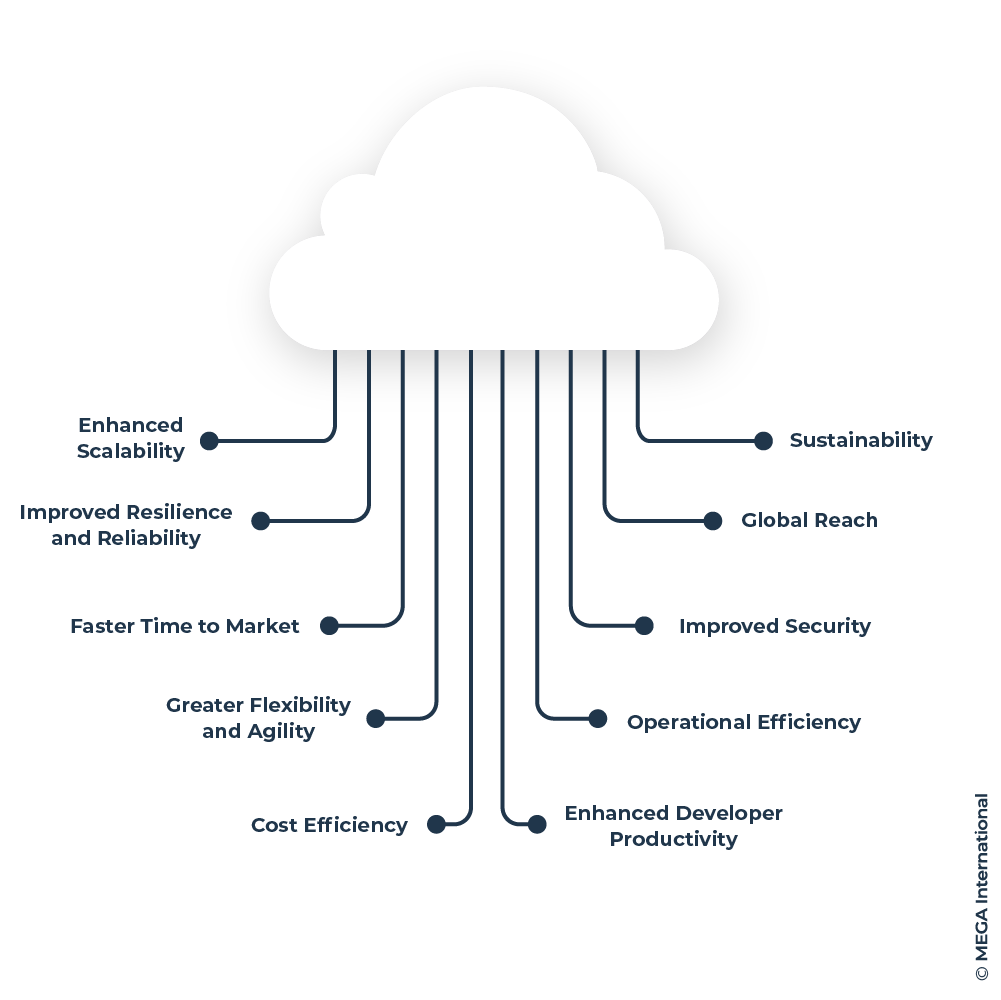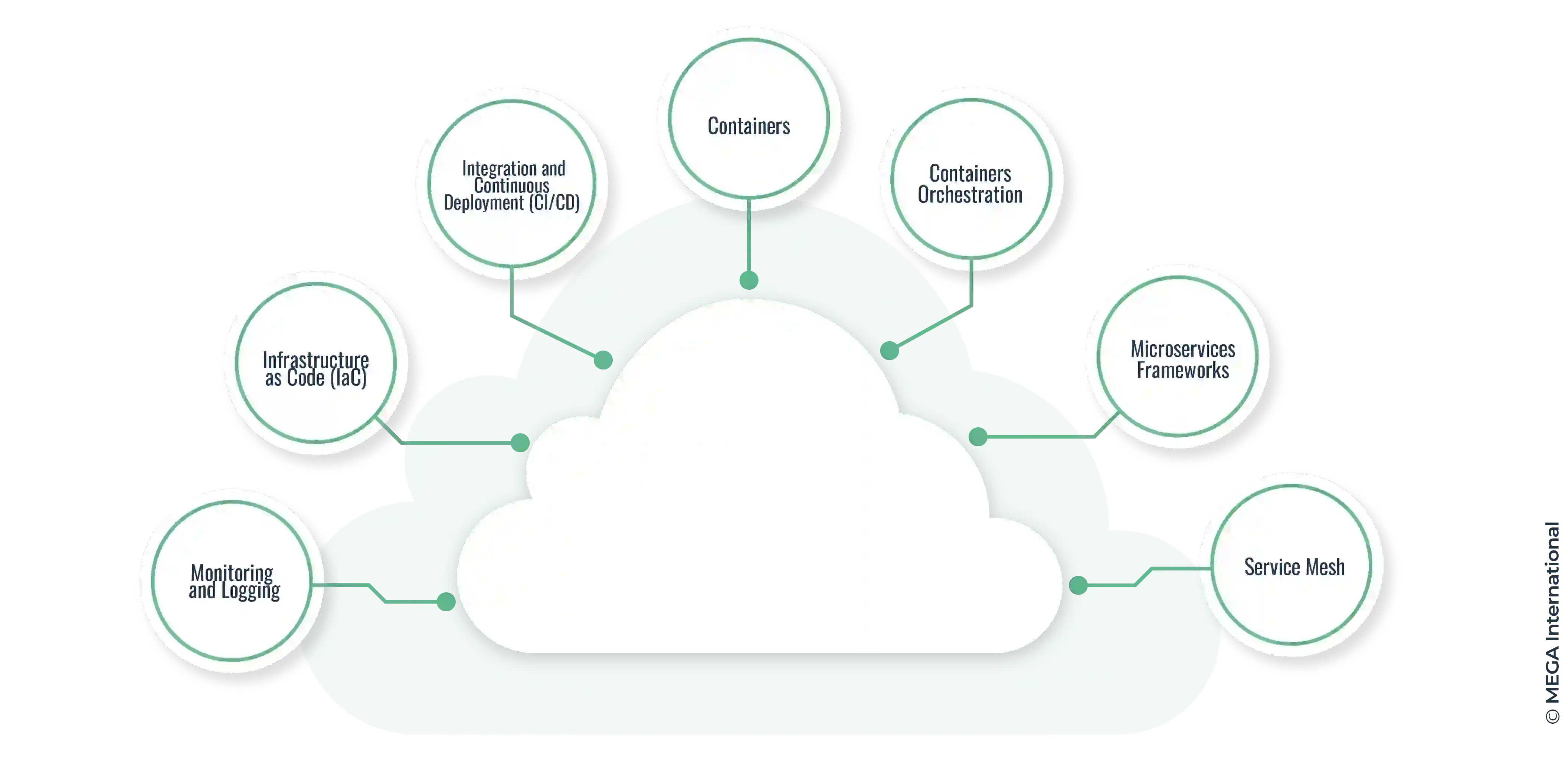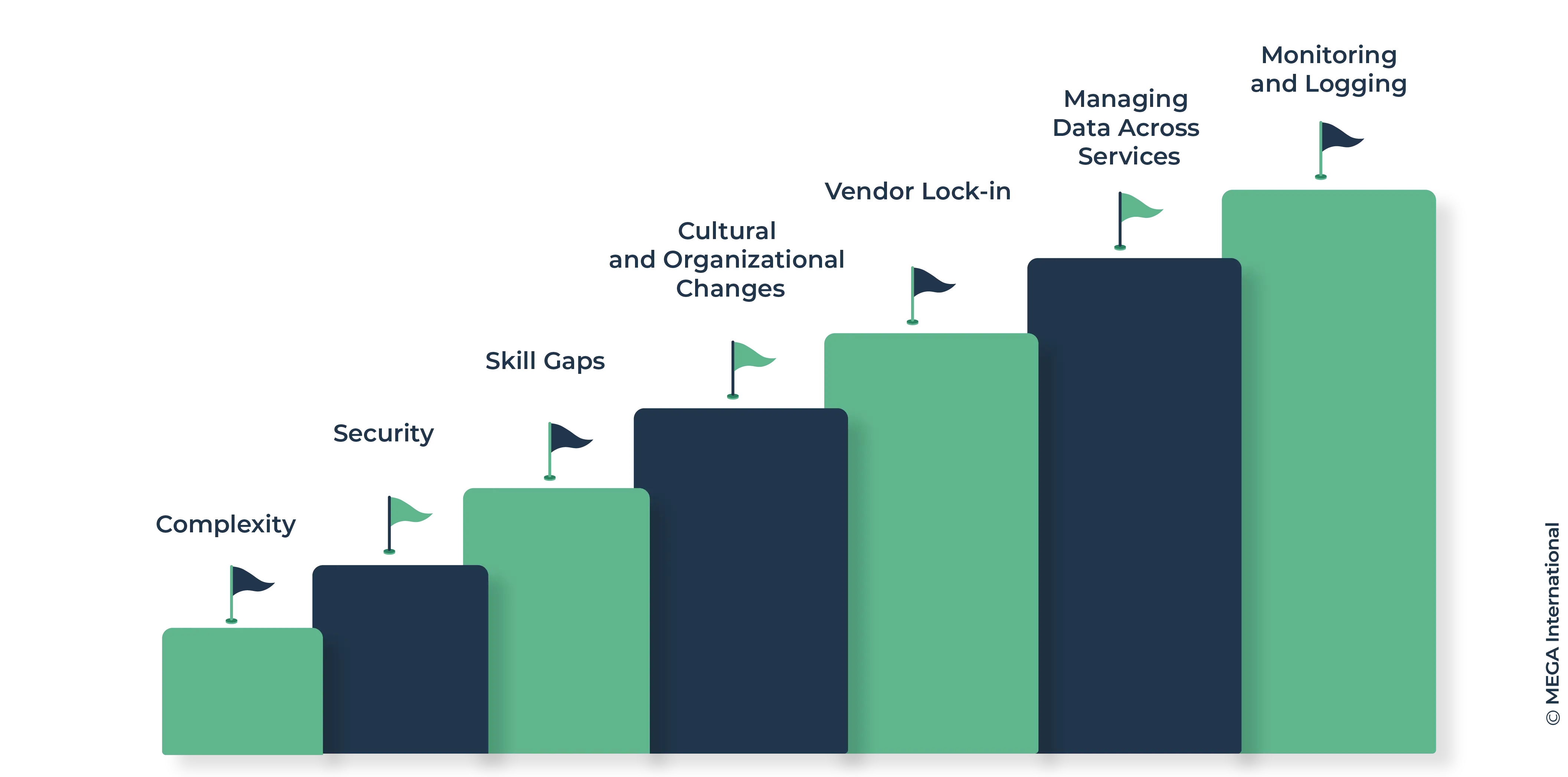
Discover the Power of Cloud-Native Architecture
Cloud-native architecture represents a significant shift in how businesses deploy and manage applications. Organizations can improve agility, scalability, and reliability by leveraging the cloud's full capabilities.
This article explores cloud-native architecture's fundamentals, benefits, and challenges, providing a comprehensive guide for those looking to embrace this transformative approach.
Understanding the Basics of Cloud-Native Architecture
Cloud-native architecture is a modern approach to building and running applications that fully exploit the advantages of the cloud computing model. Unlike traditional architecture, which often involves deploying monolithic applications on specific hardware or in on-premises data centers, cloud-native architecture emphasizes scalability, flexibility, and resilience by using cloud providers' fully managed services.
What is cloud-native architecture, and how does it differ from traditional architecture?
The transition to cloud-native architecture is driven by several fundamental principles that distinguish it from traditional application development and deployment methods.
Core Principles of Cloud-Native Architecture:

- Microservices Architecture: One of the central tenets of cloud-native architecture is the use of microservices, which involves breaking down applications into more minor, independently deployable services. Each microservice is designed to perform a specific function and can be developed, deployed, and scaled independently. This approach enables more accessible updates, faster time-to-market, and more resilient systems to isolate failures better.
- Containers: Containers provide a lightweight mechanism for encapsulating an application and its dependencies into a single, portable unit. This container can run consistently across any environment, from a developer's local machine to the cloud. Containers support the cloud-native principle of immutability and reproducibility, where applications are built once and deployed anywhere without modification.
- Dynamic Orchestration: Orchestration tools like Kubernetes manage containerized applications' deployment, scaling, and operations across clusters of hosts. Dynamic orchestration ensures that applications run optimally, handling tasks such as failover, scaling, and self-healing without manual intervention, thus supporting high availability and efficient resource use.
- DevOps and Continuous Integration/Continuous Deployment (CI/CD): Cloud-native architecture embraces DevOps practices, emphasizing collaboration, automation, and fast feedback loops between development and operations teams. Continuous Integration and Continuous Deployment pipelines automate the process of integrating code changes, testing, and deploying them to production environments, enabling faster releases and more reliable applications.
- Infrastructure as Code (IaC): IaC is a practice where infrastructure provisioning and management are automated and managed through code rather than manual processes. This allows the infrastructure to be versioned, reused, and shared, facilitating consistent and repeatable environments across development, testing, and production.
- Immutable Infrastructure: In cloud-native environments, infrastructure is treated as immutable, meaning once it is deployed, it is not modified. Instead, changes are made by replacing components rather than updating them. This approach reduces inconsistencies and potential errors during deployments and rollbacks.
- Service Mesh: A service mesh is an infrastructure layer that facilitates service-to-service communications in a microservices' architecture, providing capabilities like load balancing, service discovery, encryption, and authentication. It enables fine-grained control and observability over microservices, enhancing security and reliability.
- Observability and Monitoring: Observability is a crucial aspect of cloud-native architecture, involving the collection, analysis, and visualization of data (logs, metrics, and traces) from applications and infrastructure. This allows teams to understand the state of their system, diagnose issues, and make informed decisions based on real-time data.
- Elastic Scalability: Cloud-native systems are designed to scale resources up or down based on demand automatically. This elasticity ensures that applications can handle varying loads efficiently, optimizing resource usage and cost.
- Resilience and Fault Tolerance: Emphasizing resilience, cloud-native architecture designs systems that can tolerate failures and continue to operate. Techniques such as circuit breakers, retries, and timeouts help ensure that applications remain available and responsive, even in the face of errors or infrastructure issues.
Benefits of Cloud-Native Architecture
Cloud-native architecture brings many benefits to organizations by leveraging the full potential of cloud computing. These advantages enable businesses to innovate faster, adapt to changing needs more efficiently, and deliver reliable customer service. Here are some of the key benefits of adopting a cloud-native approach:

- Enhanced Scalability: Cloud-native applications can scale more efficiently and effectively due to their use of microservices and containers. This allows for precisely mounting individual components based on demand without climbing the entire application. The dynamic orchestration capabilities of platforms like Kubernetes further automate this process, ensuring that resources are optimized in real time.
- Improved Resilience and Reliability: The distributed nature of cloud-native applications, combined with practices like automated rollbacks and canary deployments, significantly enhance their resilience. Cloud-native systems can ensure high availability and minimize downtime by designing for failure, even in individual component failures.
- Faster Time to Market: Adopting DevOps practices, continuous integration, and continuous deployment (CI/CD) pipelines in cloud-native architecture accelerates the entire development lifecycle. This enables organizations to bring new features and improvements to the market more quickly, staying ahead of competitors and responding swiftly to customer demands.
- Greater Flexibility and Agility: Cloud-native architecture allows organizations to leverage many cloud services and technologies, making experimenting with and adopting new tools to drive business value easier. This flexibility supports a culture of innovation and continuous improvement, allowing businesses to pivot and adapt to market changes rapidly.
- Cost Efficiency: Cloud-native applications can reduce operational costs by utilizing cloud resources more effectively. Pay-as-you-go pricing models and the ability to automatically scale down resources during low-demand periods help avoid unnecessary expenses. Furthermore, containerization and microservices can lead to more efficient use of underlying resources, further driving down costs.
- Enhanced Developer Productivity: Cloud-native principles such as microservices and containers simplify the development process, allowing developers to focus on writing code rather than managing infrastructure. Additionally, CI/CD pipelines and DevOps practices reduce the overhead of deploying and managing applications, freeing developers to concentrate on innovation and feature development.
- Operational Efficiency: Automating deployment, scaling, and management tasks associated with cloud-native applications reduces the operational burden on IT teams. This allows for more efficient use of human resources, with IT staff able to focus on strategic initiatives rather than routine maintenance.
- Improved Security: Cloud-native architectures can enhance security posture using automated compliance policies, fine-grained access controls, and container isolation. Continuous delivery processes enable rapid patching and updates, reducing the window of vulnerability to security threats.
- Global Reach: Cloud-native applications can easily leverage the global infrastructure of cloud providers, allowing for the deployment of applications in multiple regions around the world. This global reach ensures lower latency for end-users and compliance with local data sovereignty requirements.
- Sustainability: By optimizing resource use and reducing the need for over-provisioning, cloud-native applications contribute to more sustainable computing practices. Efficient scaling and energy-efficient cloud data centers can lead to a lower carbon footprint for IT operations.
How does cloud-native architecture enhance application scalability and flexibility?
Cloud-native architecture fundamentally changes how applications are developed, deployed, and scaled, offering unparalleled scalability and flexibility. This is achieved through:
- Microservices: By structuring applications as a collection of loosely coupled microservices, cloud-native designs allow for the independent scaling of application components. This means that only the necessary parts of the application are scaled, optimizing resource use and response times without the need to scale the entire application.
- Containers and Orchestration: Containers provide a consistent environment for applications, from development through production, eliminating the "it works on my machine" problem. Orchestration tools like Kubernetes manage these containers, automating deployment, scaling, and operations, which further enhances scalability and allows for more flexible resource management.
- Elasticity: Cloud-native applications can automatically adjust their resource consumption based on demand, thanks to the elastic nature of cloud resources. This ensures that applications can handle peak loads efficiently and helps reduce costs by scaling down resources during periods of low demand.
Exploring the role of cloud providers in supporting cloud-native solutions
Cloud providers play a crucial role in enabling and supporting cloud-native solutions through:
- Managed Services: Cloud providers offer a range of managed services, such as databases, messaging queues, and Kubernetes clusters, which reduce the operational burden on teams and allow them to focus on application development.
- Global Infrastructure: They provide a worldwide network of data centers, ensuring applications can be deployed close to users worldwide, reducing latency, and improving performance.
- Security and Compliance: Cloud providers invest heavily in security and compliance, offering built-in security features that help protect applications and data and ensure compliance with regulatory standards.
- Innovation and Integration: They continuously innovate, introducing new services and features that enable cloud-native applications to leverage the latest cloud technology. Additionally, integrating these services allows more complex and powerful applications to be developed more efficiently.
 |  |  |
Comparing cloud-native architecture with traditional monolithic applications
The transition from traditional monolithic applications to cloud-native architecture marks a significant evolution in application design and deployment:
- Scalability: Unlike monolithic applications, which often scale by replicating the entire application stack, cloud-native applications scale by adjusting the resources allocated to individual services or components. This leads to more efficient resource use and the ability to handle variable loads gracefully.
- Development and Deployment: Cloud-native applications benefit from modern development practices such as DevOps and CI/CD, which enable faster feature development, testing, and deployment. Monolithic applications, by contrast, tend to have longer development cycles and more cumbersome deployment processes.
- Resilience: The distributed nature of cloud-native applications enhances their resilience. The failure of a single component is less likely to bring down the entire application, unlike monolithic applications, where a single point of failure can have widespread effects.
- Technology Stack Flexibility: Cloud-native architecture uses different technology stacks across various application components, enabling the best tool for each job. Monolithic applications typically use a single technology stack throughout, which can limit their ability to leverage new technologies.
Key Technologies in Cloud-Native Architecture
Cloud-native architecture leverages critical technologies to optimize application development, deployment, and management in cloud environments. These technologies support cloud-native design principles, such as microservices, containers, dynamic orchestration, and continuous delivery, enabling organizations to build scalable, resilient, and agile applications. Here's an overview of the critical technologies integral to cloud-native architecture:

Containers
- Docker: Docker is a platform that enables developers to package applications and their dependencies into containers. Containers ensure consistency across different environments, making developing, testing, and deploying applications easier. Docker has become synonymous with containerization, providing the foundational technology for creating lightweight, portable, and self-sufficient containers.
Container Orchestration
- Kubernetes: Kubernetes is an open-source platform for automating the deployment, scaling, and management of containerized applications. It organizes containers into logically grouped units for easy management and discovery. Kubernetes provides self-healing, automatic rollbacks, and scaling, making it the de facto standard for container orchestration.
- OpenShift: OpenShift, developed by Red Hat, extends Kubernetes with additional features such as developer and operational-centric tools, integrated development environments (IDEs), and a focus on security at scale. It simplifies the deployment of applications on any cloud or on-premises environment.
Microservices Frameworks
- Spring Boot: Spring Boot makes creating stand-alone, production-grade Spring-based applications accessible. It simplifies the development of microservices by providing a range of out-of-the-box features for application configuration, along with embedded servers, to ease deployment.
- Micronaut: Micronaut is a modern, JVM-based, full-stack framework for building modular, easily testable microservice and serverless applications. It is designed for service discovery, easy configuration, and a low memory footprint.
Service Mesh
- Istio: Istio is a service mesh that provides a uniform way to secure, connect, and monitor microservices. It offers advanced traffic management, security policies, and observability features without requiring changes to application code.
- Linkerd: Linkerd is a lightweight service mesh that provides observability, reliability, and security for cloud-native applications. It’s designed to be easy to install and use, with minimal configuration required.
Continuous Integration and Continuous Deployment (CI/CD)
- Jenkins: Jenkins is an open-source automation server that provides hundreds of plugins to support building, deploying, and automating any project. It facilitates continuous integration and continuous delivery of software projects.
- GitLab CI/CD: GitLab offers a single application for the entire software development lifecycle. Its CI/CD tool automates the software delivery process directly within the GitLab platform, from build to deployment.
Infrastructure as Code (IaC)
- Terraform: Terraform by HashiCorp enables the definition and provisioning of infrastructure using a high-level configuration language. It supports multiple cloud providers and allows infrastructure changes to be versioned and reused.
- AWS CloudFormation: CloudFormation allows developers to model and provision AWS and third-party application resources using YAML or JSON templates. It automates and simplifies the deployment of resources, ensuring consistent environments.
Monitoring and Logging
- Prometheus: Prometheus is an open-source monitoring and alerting toolkit for reliability and scalability. It collects and processes metrics from microservices, providing insights into the operational health of applications.
- Elastic Stack (ELK): Elastic Stack (comprising Elasticsearch, Logstash, and Kibana) is used to search, analyze, and visualize log data in real time. It is widely used for log aggregation and monitoring cloud-native applications.
Implementing Cloud-Native Architecture Solutions
Implementing cloud-native architecture is a strategic initiative that enables organizations to leverage the full benefits of cloud computing for their applications. It involves a comprehensive approach, including strategy development, technology selection, and team training. Each component ensures a successful transition to cloud-native principles and practices.
Strategy Development
Developing a strategy for cloud-native implementation is the foundational step. This involves:
- Assessing Current Infrastructure: Understanding the existing application portfolio and infrastructure is crucial in identifying which applications are suitable for a cloud-native approach and which may require significant refactoring or redevelopment.
- Defining Business Objectives: Align the cloud-native adoption strategy with business goals. Clear objectives will guide the transformation process, whether it's improving scalability, enhancing deployment speeds, or reducing operational costs.
- Planning the Transition: Create a detailed roadmap for the transition. This includes selecting which applications to start with, deciding on a phased approach versus a big-bang adoption, and identifying key milestones and metrics for success.
- Risk Management: Identify potential risks and challenges associated with moving to a cloud-native architecture, such as security concerns, compliance issues, and possible downtime. Develop a plan to mitigate these risks.
Technology Selection
Choosing the right technologies is critical to the successful implementation of cloud-native architecture. This involves:
- Containerization Tools: Decide on containerization platforms, such as Docker, that will form the basis for packaging and deploying applications.
- Orchestration Solutions: Select an orchestration tool, like Kubernetes, that matches the organization's operational model and scalability needs.
- Microservices Frameworks: Choose appropriate frameworks and languages that support microservices development, considering factors such as existing expertise, community support, and performance.
- DevOps Tools: Implement tools that support DevOps practices, including CI/CD pipelines (e.g., Jenkins, GitLab CI/CD), infrastructure as code (e.g., Terraform, AWS CloudFormation), and version control systems.
- Monitoring and Observability: Adopt monitoring and observability tools (e.g., Prometheus, Elastic Stack) that provide insights into application performance and help troubleshoot issues.
Team Training
Equipping the team with the necessary skills and knowledge is essential for a successful cloud-native transformation. This includes:
- Skills Development: Identify skill gaps within the team and provide training on cloud-native technologies and practices, such as container management, microservices design, and cloud security.
- Adopting New Workflows: Train the team on new workflows and methodologies, including DevOps practices, agile development, and CI/CD processes, to enhance collaboration and efficiency.
- Cultural Change: Foster a culture of continuous learning and experimentation. Encourage teams to embrace the cloud-native mindset, which includes agility, resilience, and a focus on delivering value.
- Community Engagement: Encourage participation in cloud-native communities and forums. Engaging with the broader community can provide valuable insights, support, and best practices.
Implementing cloud-native architecture is a complex process that requires careful planning, the right technology stack, and a skilled team ready to adapt to new working methods.
Challenges of Cloud-Native Architecture
Implementing cloud-native architecture offers numerous benefits. However, organizations embarking on this journey may encounter several challenges that must be carefully managed to ensure a successful transition. Understanding these challenges is crucial for planning effective strategies to overcome them.

Complexity
Cloud-native apps, being distributed systems, are more complex than monolithic architectures. Managing multiple microservices, maintaining communication, and ensuring data consistency pose challenges. Orchestrating containers dynamically adds operational complexity, necessitating advanced monitoring tools and infrastructure expertise.
Security
Cloud-native architectures improve security with isolation and automated updates but introduce new risks. Microservices' distributed nature and increased inter-service communication can create more attack opportunities.
Consistent security policies, secret management, and secure communications demand a robust strategy integrated into the cloud-native environment.
Skill Gaps
The shift to cloud-native technologies requires new skills and expertise, from containerization and microservices to dynamic orchestration and infrastructure as code.
Organizations may find that their IT staff must learn to effectively design, deploy, and manage cloud-native applications. Bridging this skill gap often involves significant training and may require recruiting new talent with specialized expertise in cloud-native technologies.
Cultural and Organizational Changes
Adopting cloud-native architecture is not just a technological shift but also a cultural one. It requires changes in teams' operations, emphasizing DevOps principles, continuous delivery, and agile methodologies. This can be a significant shift for organizations used to more traditional development and deployment practices, requiring changes in mindset, processes, and collaboration across departments.
Vendor Lock-in
While using managed services from cloud providers can accelerate the adoption of cloud-native architecture, it can also lead to vendor lock-in.
Organizations might become overly reliant on a single cloud provider's specific technologies and services, making switching providers or deploying solutions across multiple clouds difficult and costly.
Careful selection of cloud services and consideration of open standards and portability can help mitigate this risk.
Managing Data Across Services
Data management becomes more complex in a microservices architecture. Ensuring data consistency, implementing transactions across services, and managing distributed data storage systems pose significant challenges. Organizations need to adopt new strategies for data management, such as event sourcing or implementing a database per service, which can introduce additional complexity and learning curves.
Monitoring and Logging
The dynamic and distributed nature of cloud-native applications complicates monitoring and logging. Traditional monitoring tools may not be suitable for containers and microservices' transient and scalable nature. Organizations must implement robust tracking, logging, and observability platforms that can provide insights into the health and performance of applications across multiple services and infrastructure components.
Cloud-Native Architecture Case Studies
Case Study 1: Financial Services Firm Enhances Compliance and Innovation
A financial services firm faced challenges with regulatory compliance and the rapid deployment of new features due to its outdated infrastructure and development practices.
| Solution: By adopting a cloud-native architecture, the firm utilized microservices to isolate and manage different aspects of its application, from customer-facing services to backend processing. This isolation simplified compliance with industry regulations by allowing for targeted security measures and audits. The firm leveraged Kubernetes for orchestration, ensuring that resources were efficiently allocated and scaled according to demand. |
Outcome: The cloud-native transformation markedly improved the firm's ability to meet compliance requirements efficiently. The modular nature of microservices and the agility of cloud-native practices enabled the firm to innovate and deploy new features at a previously unattainable pace, improving competitiveness and customer satisfaction.
Case Study 2: Healthcare Provider Improves Patient Care with Cloud-Native
A healthcare provider aimed to improve patient care by enhancing its data processing capabilities, enabling real-time analysis of patient data to offer personalized care plans.
| Solution: The provider shifted to a cloud-native architecture, leveraging microservices for data processing tasks, such as patient data ingestion, analysis, and reporting. This approach facilitated the integration of advanced analytics and machine learning models. Using containers and Kubernetes orchestration allowed for the flexible deployment of these services across cloud environments, ensuring high availability and security. |
Outcome: The cloud-native strategy significantly improved healthcare providers' ability to process and analyze patient data in real time. This led to more accurate and timely insights into patient health, allowing for personalized care plans and interventions. The scalable nature of the cloud-native infrastructure also ensured that the system could handle growing data volumes as the provider expanded its services.
These case studies demonstrate the versatility and benefits of cloud-native architecture across different sectors.
The Future of Cloud-Native Architecture
As organizations increasingly adopt cloud-native principles, several trends and predictions emerge, pointing to the future direction of this transformative approach to building and deploying applications.
Trends
- Serverless Computing: The rise of serverless computing is a significant trend in cloud-native architecture. Serverless models abstract the underlying infrastructure further, allowing developers to focus solely on writing code without worrying about provisioning or managing servers. This trend is expected to grow as it offers scalability, cost savings, and operational simplicity.
- Service Mesh Adoption: As microservices architectures become more complex, the need for efficient service-to-service communication increases. Service mesh technologies like Istio and Linkerd are gaining traction due to their ability to provide seamless connectivity, security, and observability across microservices without requiring changes to the application code.
- GitOps: A methodology that uses Git repositories as the source of truth for defining and managing the state of cloud-native applications and infrastructure is gaining popularity. This approach enhances automation, consistency, and collaboration, making implementing continuous deployment for cloud-native environments easier.
- Edge Computing: The growth of IoT and mobile devices is driving the expansion of cloud-native architectures to the network's edge. Edge computing, which processes data closer to its source, reduces latency and bandwidth use, enhancing the performance of cloud-native applications that require real-time processing.
- Multi-Cloud and Hybrid Cloud Strategies: Organizations increasingly adopt multi-cloud and hybrid cloud strategies to avoid vendor lock-in, enhance resilience, and meet regulatory and data sovereignty requirements. Cloud-native technologies supporting portability and interoperability across different environments are becoming essential.
Predictions
- Increased AI and Machine Learning Integration: Cloud-native architectures will increasingly incorporate AI and machine learning services, enabling more intelligent and automated application features. This integration will enhance the ability of applications to adapt in real-time, provide personalized experiences, and improve operational efficiency.
- Sustainability Focus: As environmental concerns become more pressing, cloud-native architectures will evolve to prioritize sustainability. This will involve optimizing resource use to reduce energy consumption and carbon footprint, leveraging the inherent efficiency of cloud-native technologies.
- Enhanced Security and Compliance: Security and compliance will become more integrated into cloud-native architectures. Automated security policies, enhanced encryption, and compliance as code will become standard practices, driven by the need to protect against increasingly sophisticated cyber threats.
- Proliferation of Open Source: The cloud-native ecosystem will continue to be driven by open-source technologies. Community-driven innovation in open-source projects will lead to the rapid development and adoption of new cloud-native tools and practices.
- Developer Experience Focus: A greater focus will be on improving the developer experience in cloud-native ecosystems. Tools and platforms that simplify the development, deployment, and management of cloud-native applications will become more prevalent, reducing complexity and accelerating innovation.
| The future of cloud-native architecture is bright, with ongoing innovations that promise to make cloud-native ecosystems more robust, efficient, and secure. As these trends and predictions unfold, organizations that adapt and embrace these changes will be well-positioned to leverage the full potential of cloud-native technologies to drive business growth and innovation. |
Final Thoughts
Cloud-native architecture is not merely a technological trend, but a foundational shift in how organizations build and manage applications in the cloud era. As this architecture continues to evolve, it will unlock new opportunities for innovation, efficiency, and growth. Organizations willing to invest in cloud-native strategies and navigate its complexities will find themselves well-equipped to lead in the digital age, leveraging the full power of cloud computing to achieve their business objectives.
FAQs
Cloud-native architecture is an approach that utilizes microservices and containers, along with automation and deployment practices, to build and run scalable and resilient applications in cloud environments. It optimizes application architecture for cloud computing by leveraging cloud-native services and technologies.
Cloud-native architecture is designed specifically for cloud environments and follows the principles of cloud-native computing. It emphasizes automation, scalability, and resilience through microservices architecture and containerization, whereas traditional architecture typically revolves around monolithic applications and may not be optimized for cloud deployment.
Microservices are vital to cloud-native architecture as they decompose applications into smaller, independently deployable units. This facilitates agile development, scalability, and resilience, making updating and maintaining cloud-native systems easier.





